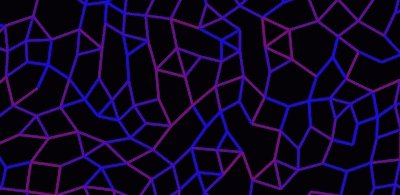Fibrous materials
Biological fibrous networks, such as actin networks in the cell cortex, collagen in tissues or fibrin in blood clots, exhibit non-linear mechanical properties. We aim to understand the microscopic origin of this generic behaviour using both experimental and numerical tools.
Felt Mechanics We use synthetic felt as a model system to study fibrous network mechanics. During uniaxial tests on a strip of material, we record the elongational stress and the geometry (width and thickness). The material exhibits a non-linear mechanical behaviour (strain stiffening) and a high Poisson ratio. Independent measurements of the single fiber response proved that the fiber non-linearity originates from its curly natural geometry. Focussing on the reversible part of the response, we found that the mechanical response can be related to the single fibre response. In particular, the high value of the Poisson ratio is a direct consequence of the fact that any fiber is stiffer in extension (ultimately material stretching) than compression (fiber buckling). |
Elastic fiber alignments in collagen networks
Coworkers: D. Vader, L. Jawerth, D.A. Weitz, L. Mahadevan
Collagen is the most abundant network forming protein: it is the main component of the extracellular matrix and plays a key role in tissue engineering techniques. Cells in such a material typically generate local tensile forces who might affect the overall network morphology. We explore experimentally the mechanical response of fibrous networks by mimicking in collagen gels the typical mode of deformation that live cells impose on the network. We observe upon local stretching a strong alignment of the fibers and a large densification of the network. For pure type I collagen gels, this alignment is irreversibly imprinted in the network; this offers a simple mechanism for self-organization at the microscale. However, the same behavior is maintained and become reversible when the binding strength is increased by addition of a crosslinker. This demonstrates that fiber alignment is primarily an elastic effect and part of the fundamental non-linear properties of fibrous biological networks. This provides a baseline on top of which hydrodynamics effects can be conveniently studied.

Collagen type I and fluorescent particles, Confocal microscopy.
Mechanical Properties of Central Force Networks
Coworkers: Haiyi Liang, Matthieu Wyart and L. Mahadevan
Central force networks arise naturally in the study of granular and fibrous materials with implications for the mechanical behavior of hierarchical materials such as nano-composites, cytoskeleton mechanics and tissue engineering. Using simulations based on a damped molecular dynamics approach, we study the soft and stiff modes of deformation in both Gaussian and Poissonian networks of random linear springs with the goal of understanding the onset of elasticity, and the eventual strain-stiffening in these networks. Although the individual springs are linear, we see that collectively the systems are nonlinear due to the effects of rotation and alignment (or the lack thereof). For small to intermediate deformations, we observe that the systems have negative Poisson's ratio. We observe a strong dependence of the above quantities on the coordination number in systems, which effect may be rationalized using some classical arguments going back to the work of Maxwell. Floppy (almost zero energy) modes play a central role in the deformation process, and are responsible for both the softening and stiffening behavior of these networks; in fact strain stiffening is due to the annihilation of these floppy modes. Some implications of these results for the design and behavior of hierarchical materials will be outlined.
Work in progress... contact us for more details.

A floppy central force network. Mean coordination: 3.61


